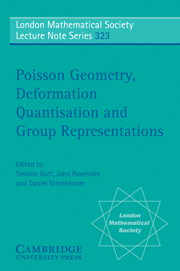Book contents
- Frontmatter
- Contents
- Preface
- Part One Poisson geometry and morita equivalence
- Part Two Formality and star products
- Part Three Lie groupoids, sheaves and cohomology
- 1 Introduction
- 2 Lie groupoids
- 3 Sheaves on Lie groupoids
- 4 Sheaf cohomology
- 5 Compactly supported cohomology
- Bibliography
- Part Four Geometric methods in representation theory
- Part Five Deformation theory: a powerful tool in physics modelling
- Index
3 - Sheaves on Lie groupoids
Published online by Cambridge University Press: 04 August 2010
- Frontmatter
- Contents
- Preface
- Part One Poisson geometry and morita equivalence
- Part Two Formality and star products
- Part Three Lie groupoids, sheaves and cohomology
- 1 Introduction
- 2 Lie groupoids
- 3 Sheaves on Lie groupoids
- 4 Sheaf cohomology
- 5 Compactly supported cohomology
- Bibliography
- Part Four Geometric methods in representation theory
- Part Five Deformation theory: a powerful tool in physics modelling
- Index
Summary
In Chapter 2 we have introduced the notion of a Lie groupoid, and we have shown how singular spaces (such as the space of leaves of a foliation) can be represented by weak equivalence classes of Lie groupoids.
The purpose of the present chapter is two-fold. First, we will introduce the category of equivariant sheaves for a Lie groupoid G, as well as its derived category. As will become apparent, these categories are particularly relevant for étale groupoids, and more generally for foliation groupoids. Secondly, we will give an explicit construction of the fundamental groupoid π1(G) associated to a Lie groupoid G. These constructions are related in a Grothendieck style way, by the fact that the fundamental groupoid is determined by the locally constant sheaves.
We begin in Section 3.1 with an explicit description of equivariant sheaves for a groupoid, and give some examples. In Section 3.2 we study how the category of G-sheaves behaves with respect to homomorphisms of Lie groupoids. We show that the category of G-sheaves is in fact functorial with respect to the generalized morphisms, and that a weak (or Morita) equivalence between Lie groupoids induces an equivalence of the associated categories of sheaves.
In Section 3.3 we discuss the fundamental group of a Lie groupoid. More precisely, we construct for each Lie groupoid G a new Lie groupoid π1(G). This groupoid is weakly equivalent to a discrete groupoid. In particular, the isotropy groups of π1(G) are discrete. If G is connected, these isotropy groups of π1(G) are all isomorphic to each other, and will be referred to as ‘the’ fundamental group of G.
- Type
- Chapter
- Information
- Publisher: Cambridge University PressPrint publication year: 2005

